How To Eat 14 Popular Japanese Dishes Correctly

Have you ever hesitated about eating a Japanese dish because you weren't sure how exactly you should eat it? This article covers how to properly eat tempura, udon, tonkatsu, onigiri rice balls, and other classic washoku cuisine. Learn when to use chopsticks and when to use your hands!
How to Eat Japanese Food - Dishes that Taste Better with Proper Manners
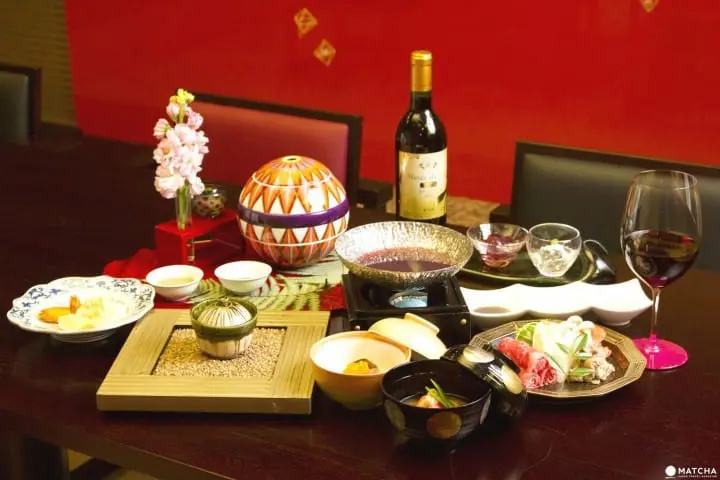
Picture from Hoshino Resorts KAI Matsumoto - A Refined Stay In The City Of Art And Music
Japan boasts unique dishes such as sushi and tempura. Although you can taste these dishes in other countries, too, the authentic taste of those prepared in Japan is an extraordinary experience you have to enjoy in-person.
No matter if you are at home or in Japan, eating a Japanese dish properly allows diners enjoy its flavor to the fullest. In this article, we explain how to eat sushi, tempura, soba, udon, tsukemen noodles, yakitori, sukiyaki, tonkatsu, natto, onigiri, gyoza, shabu-shabu and hitsumabushi like the Japanese.
How to eat ...
1. How to Eat Sushi
2. How to Eat Tempura
3. How to Eat Ramen
4. How to Eat Udon Noodles
5. How to Eat Soba Noodles
6. How to Eat Tsukemen
7. How to Eat Yakitori
8. How to Eat Tonkatsu (Pork Cutlet)
9. How to Eat Onigiri (Rice Balls)
10. How to Eat Sukiyaki
11. How to Eat Shabu-Shabu
12. How to Eat Natto
13. How to Eat Gyoza Dumplings
14. How to Eat Hitsumabushi
1. How to Eat Sushi

Sushi is a traditional Japanese dish and was the very first dish that spread the appeal of Japanese food to the world. There are many enthusiastic fans of sushi all over the world now. As you might know, nigiri-zushi (hand-shaped sushi) which has a slice of raw fish on top of rice is usually eaten with soy sauce and wasabi.
Wasabi, which is well known for causing a spicy burning sensation in your nose and sinuses, is not liked by everybody. If you don't like wasabi, please tell the staff "sabi nuki" (without wasabi) when you order your sushi in Japan.
The best way to enjoy sushi is by eating each piece with your hand. Using chopsticks is also acceptable, but if you ask the sushi chefs, they'll all encourage you to it by hand. This will prevent the sushi from falling apart.
When you dip sushi into the soy sauce, flip the sushi over so that the fish absorbs some soy sauce rather than the rice; this way the rice won't soak up too much soy sauce and you won't lose the flavor of the fish itself.
↑ Return to the top of article.
2. How to Eat Tempura

Tempura is a common dish made from meat, fish or edible plants that are dipped into a mixture of flour, water and eggs then fried in oil. These crunchy and flavorful foods are almost addictive! You won't be able to stop eating them.
The standard way of eating tempura is by dipping each piece of tempura in ten-tsuyu, a special dipping sauce. Ten-tsuyu is made from dashi soup stock, soy sauce and mirin (sweet rice wine). You can also add grated Japanese daikon radish and grated ginger to ten-tsuyu which bring a sharp freshness to its dish.
The order of eating its tempura pieces is also important. If several pieces of tempura are served on one plate, you should start with lighter types of food (such as vegetables and shrimp) first and then move onto heavier types of food such as anago eel.
↑ Return to the top of article.
3. How to Eat Ramen

Ramen is one of the most popular dishes in Japan. You will often see long lines of people waiting in front of famous ramen shops. If you enter a ramen shop, you'll use the ticket machine at the entrance to select the type of ramen you want and make the payment. Hand in the ticket with your order to the staff and take a seat.
The noodles and toppings of ramen should be eaten with one's chopsticks. Usually, a special spoon is provided for the soup, which you can drink with the noodles. Enjoy ramen as soon as it's prepared, as the noodles can get soggy and lose flavor. You can add in extra condiments to the soup, such as garlic, sesame, chili oil, or pickled ginger, throughout your meal to enjoy the different flavors.
An important rule regarding ramen shops is that once you're finished, you should immediately give your seat to the next customer. Ramen is traditionally a casual dish to be eaten on-the-go. Ramen shops in Japan are usually very busy but have a steady flow of diners coming in and going out.
↑ Return to the top of article.
4. How to Eat Udon Noodles
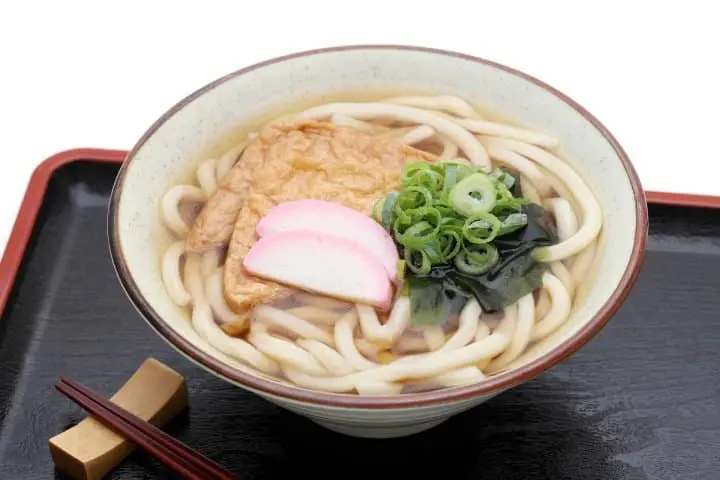
Udon is one of the best-known types of noodles in Japan. Udon is typically a thick, light-colored noodle made from wheat flour and salted water. It is a popular noodle, often served at homes and restaurants across the country. How you eat udon changes depending on how it is served, but it is a dish to be enjoyed with chopsticks, and eaten soon after being served, as the udon can become soggy and lose flavor if left sitting too long.
For the cold noodles that come without broth, like zaru udon, you will dip noodles into a separate sauce and then eat the udon. First, add wasabi and spices like green onions into the sauce. Then, take a few noodles with your chopsticks and dip the udon into the sauce. Don't leave the noodles in the sauce for long.
On the other hand, if the noodles are hot and already in the soup (known as "kake udon" in Japanese), pick up the noodles with chopsticks and slurp them down. If your bowl comes with a spoon, scoop up a small amount of broth, and pick up the noodles in your other hand with your chopsticks, holding the bottom of them with your spoon. This is the way most people in Japan enjoy hot udon and other noodle dishes. Feel free to add sesame seeds or shichimi (seven-spice blend) for some extra flavor to the broth.
For the toppings on udon, such as tempura, fried tofu, naruto (fish cake), and vegetables or meat, simply use your chopsticks to eat them along with the noodles. You can use the same spoon and chopstick method to enjoy the toppings with the savory broth.
↑ Return to the top of article.
5. How to Eat Soba Noodles
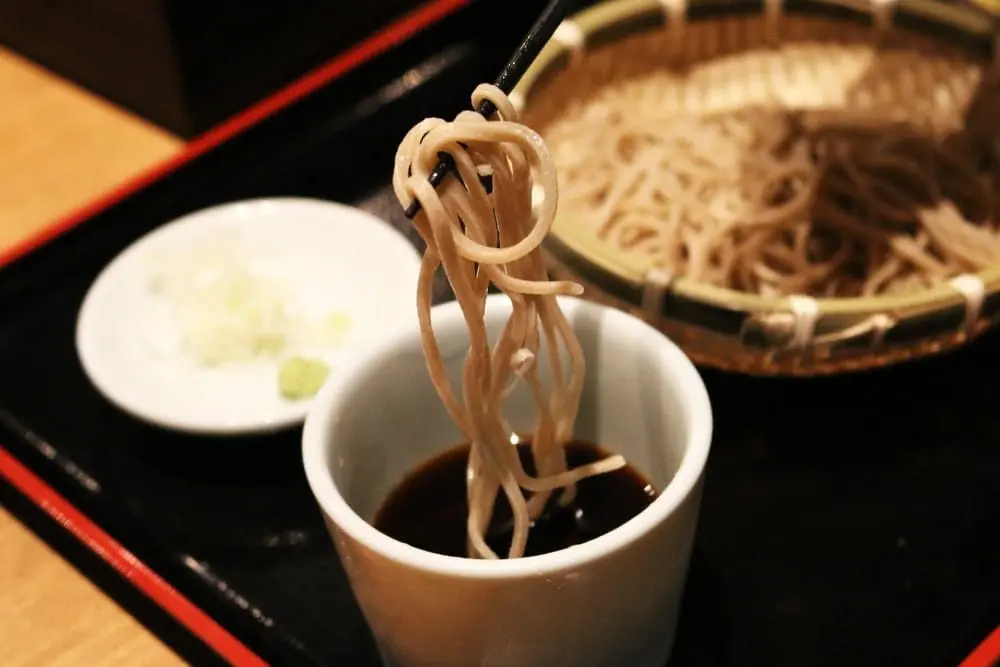
Another famous type of noodle in Japan is soba, or buckwheat noodles. Thinner and darker in color than udon, soba has a slightly nutty, hearty taste and texture. Like udon, the way soba is eaten depends on its preparation, and diners should enjoy it soon after being served for the maximum flavor and texture.
To enjoy chilled soba, such as zaru soba, or seiro soba, eat it with chopsticks, dipping the noodles into the sauce container. Feel free to use the condiments on the side to change the flavor of the sauce. Similar to udon, common add-ins are green onion, daikon radish, wasabi, ginger, sesame, and spices.
For warm soba, known as "kake soba" in Japanese, use your chopsticks and, if provided, a spoon to pick up the noodles and any toppings. Feel free to make a slurping sound. After enjoying soba noodles, you can drink the water that boiled the soba with your leftover soup or sauce. Known as "soba-yu" in Japanese, this broth is nutritious and an excellent, filling way to finish your meal. It is available at many restaurants in Japan, or can be enjoyed at home.
↑ Return to the top of article.
6. How to Eat Tsukemen
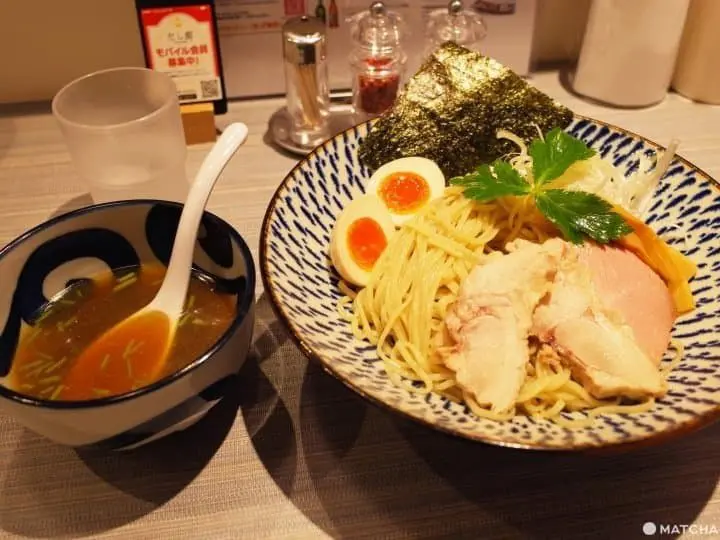
As we mentioned above, tsukemen is a ramen dish wherein the noodles and soup are served separately. The temperature difference between the hot soup and cold noodles is a taste sensation that many find addictive.
The standard way of eating tsukemen is to pick up a mouthful's worth of noodles with your chopsticks, dip them into the soup and then slurp them up. The most important point to this is how quickly you can bring the noodles to your mouth, as the soup will cool off quickly if you take too long.
In addition, tsukemen comes with its own version of soba-yu, called soup wari. You simply ask the staff for this restaurant specific light broth, which you then add to the remaining soup and drink. This is a Japanese dish that you can enjoy right down to the very last drop. Why don't you fill your empty stomach with this happiness?
↑ Return to the top of article.
7. How to Eat Yakitori
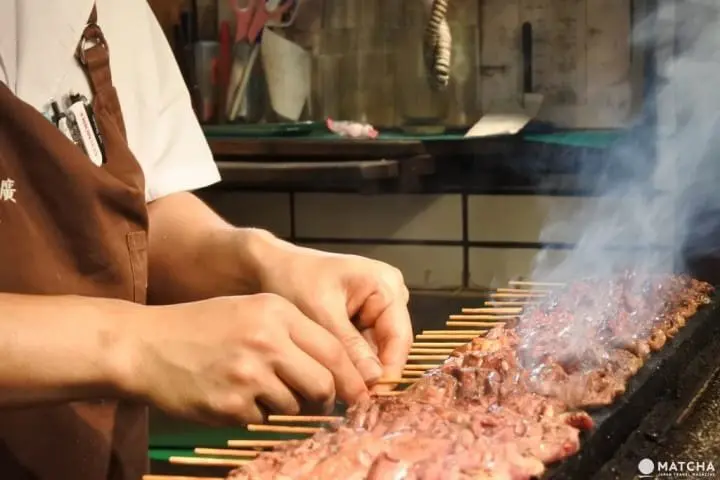
Yakitori are cubed pieces of chicken that have been skewered on bamboo sticks, seasoned and then grilled over charcoal or gas, searing in the juices. This dish is an especially good match for alcoholic drinks like beer and shochu.
The main two forms of flavoring this dish are salt or 'tare', which is a salty-sweet sauce made from soy sauce and other ingredients that vary by restaurant. People who prefer the taste of the chicken itself tend to enjoy the salted type. The yakitori made from chicken organs, however, taste quite nice when seasoned with tare.
You can eat the yakitori directly on the stick itself - simply put the used stick in the container provided on the table after you've finished.
↑ Return to the top of article.
8. How to Eat Tonkatsu (Pork Cutlet)
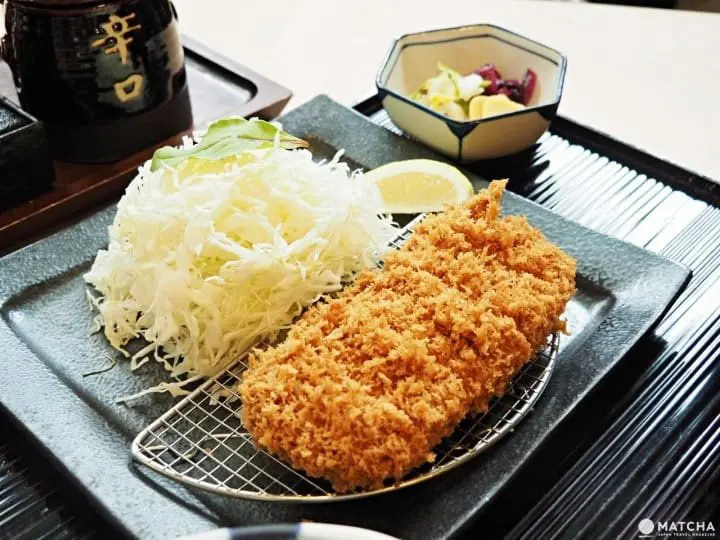
Tonkatsu, a popular standard lunch dish in Japan, is a pork cutlet that has been breaded and deep-fried. The most common tonkatsu dish is tonkatsu served with tonkatsu sauce (a sauce made from vegetable and fruit extracts, salt, sugar, vinegar and other spices), shredded cabbage, and steamed rice.
The crunchy coating and savory taste of this dish will spread all through your mouth the moment you sink your teeth in. If you want to change the flavor of the sauce, you can add karashi, a spicy Japanese mustard, or Western-style mustard to this dish.
↑ Return to the top of article.
9. How to Eat Onigiri (Rice Balls)

Onigiri are rice balls that come in a wide variety of flavors and have long been considered comfort food by the Japanese. Rice balls are often packed in bento lunches and offer a filling snack in between meals.
Onigiri comes in two major types: as a rice ball where the rice is visible, or wrapped in a sheet of dried nori seaweed. Convenience stores sell onigiri in dozens of varieties, for anywhere from 100 to 200 yen. The onigiri sold at convenience stores uses a special wrapping method in order not to break its ubiquitous shape. This packaging may appear complicated to open at first. However, it is actually quite easy to open if you follow the numbers on the packaging. Onigiri is finger food, eaten with one's hands. You do not need to use chopsticks.
This Japanese staple has become increasingly popular with travelers from overseas as a quick means of trying Japanese food on the go. Onigiri typically has a filling: some popular choices are salmon, tuna, and konbu (kelp).
↑ Return to the top of article.
10. How to Eat Sukiyaki
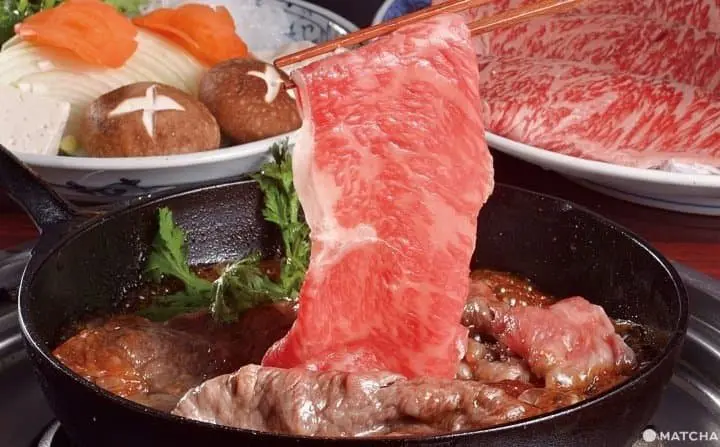
Sukiyaki is a popular cold-weather dish consisting of thinly sliced beef and vegetables like green onions and mushrooms that are cooked in a shallow iron pan in a mild stock base. It is a type of hot pot dish enjoyed at restaurants and households throughout Japan, enjoyed with chopsticks.
The way of eating sukiyaki varies by region. In Western Japan, the beef is grilled on an oiled pan first and then the vegetables are added to the pan. The broth that comes from the meat and vegetables as they cook forms the basis of this stock, to which soy sauce and sugar are later added.
On the other hand, in Kanto, or eastern Japan, the beef is not grilled first. Instead, a sauce made from the combination of soy sauce and a Japanese wine called "wari shita," is first poured into the pan, then the beef and vegetables are added. Once the ingredients have boiled, it is ready to eat.
Though the means of preparing the dish are different, the ways to finish them up are the same. Once the ingredients have been all eaten, udon noodles are added to the remaining broth; the sweet, spicy and savory taste of the soup goes very well with the noodles.
↑ Return to the top of article.
11. How to Eat Shabu-Shabu
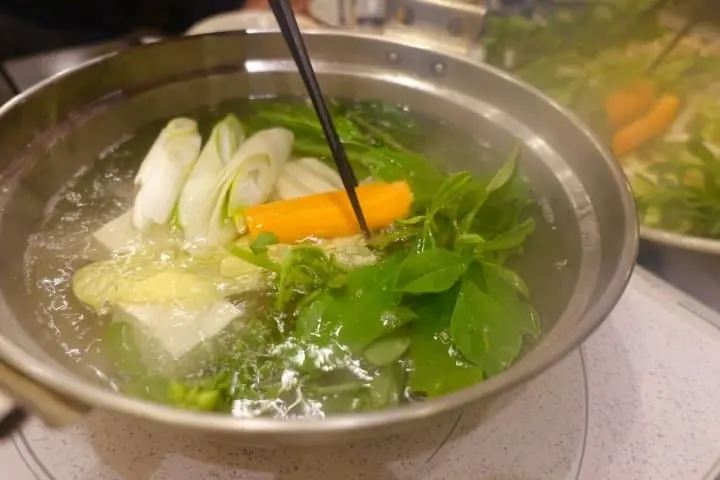
Shabu-shabu is a type of hot pot cuisine in Japan, similar to sukiyaki. A variety of ingredients, including onion, mushrooms, greens, tofu, mochi, and meat or fish, are simmered in a pot shared among a group of diners. Shabu-shabu is available at restaurants and also enjoyed at home.
Typical shabu-shabu is made with a broth of konbu kelp broth, or bonito fish. Fast-cooking ingredients like meat are dipped into the broth and swished around for several seconds with chopsticks. After it is fully cooked, take out the meat or ingredient and dip it into a dish with citrusy ponzu sauce or sesame sauce. The cooking time and method of each ingredient vary––thinly sliced vegetables and mochi cook quickly.
With a balance of different flavors and nutrients, shabu-shabu is a healthy, satisfying option. Like sukiyaki, noodles are usually placed in the broth and enjoyed at the end of the meal.
↑ Return to the top of article.
12. How to Eat Natto
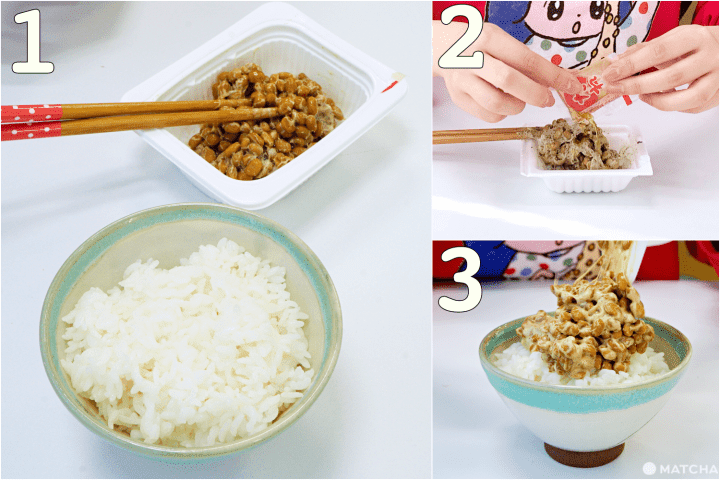
Natto is one of the most divisive foods in Japan: people who like it and those who cannot stand the smell or texture of the dish. Considered a healthy food, it is often part of a standard Japanese style breakfast.
Natto consists of fermented soybeans which are usually sold in a white styrofoam box in packs of three. Inside each package, there are two satchels of Japanese mustard and a brand-specific sauce, both of which you add to the beans and then mix them together well, ideally with chopsticks. The more you mix the natto up, the milder the texture becomes, which has an effect on how easily it can be eaten.
Then, many people scoop up the natto and put it on top of hot white rice. Easy to prepare and healthy, this dish has seen an increase in popularity in the last few years. Please give natto a try if you have the chance.
↑ Return to the top of article.
13. How to Eat Gyoza Dumplings
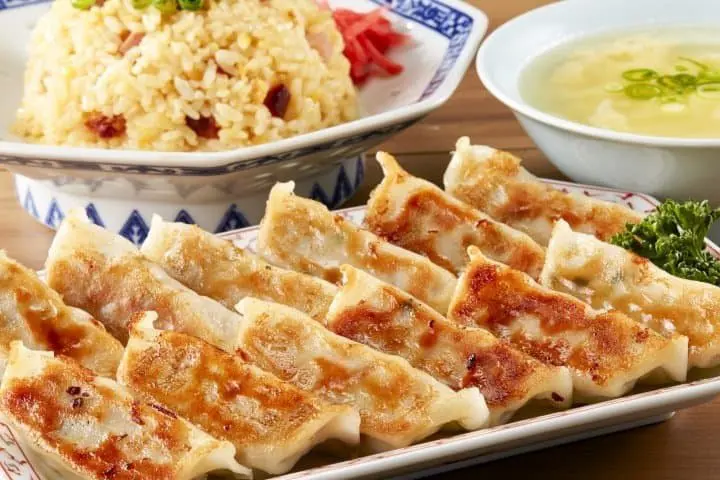
Gyoza dumplings originally came from China and are a beloved dish in Japan. These dumplings are made with a combination of ground pork, Chinese cabbage, green onions, chives and spices which are then encased in a thin flour wrapper. These dumplings are then cooked in one of three ways: grilling, steaming or boiling.
Many Japanese style restaurants serve grilled gyoza in Japan. Once your gyoza is served, you can make your own dipping sauce by combining soy sauce, vinegar, and chili oil. Be careful with the chili sauce though, as it can be spicier than it seems, so add it sparingly at first. Now that your sauce is ready, take one piece of gyoza with your chopsticks, dip its non-grilled side in the sauce and enjoy!
↑ Return to the top of article.
14. How to Eat Hitsumabushi
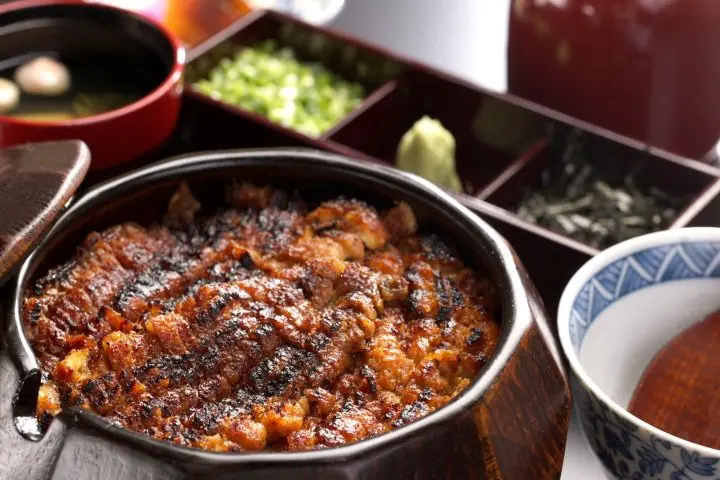
Hitsumabushi, which is a famous dish from Nagoya, is grilled eel on a bed of rice served with a sweet sauce. Hitsumabushi is most commonly eaten in three different ways.
The most popular way is to simply eat the dish as it is, with one's chopsticks, enjoying the taste of the eel on the rice itself. Many like to add spices (such as wasabi and green onions) and mix the parts together, which has a great, refreshing taste. The final step has you pour a cup of warm soup over the eel and rice, making the meat softer and further changing the flavors.
Hitsumabushi is an excellent meal for someone that wants to try a wide variety of Japanese tastes and is sold in many different places throughout Japan now, though Nagoya is still the best place to try this dish.
↑ Return to the top of article.
Enjoy Japanese Cuisine!
In this article, we introduced the main Japanese dishes and the proper way to eat them. However, the locals will often encourage you to enjoy the dishes the way you feel comfortable.
For example, sushi can be enjoyed both by hand and with chopsticks. You can drink the ramen soup if you like it or leave some of it if you're already full.
Feel free to enjoy Japanese cuisine as you like it. Remember to say "itadakimas" before you eat and "gochiso sama" after you're finished to express your thanks for the meal.
Read also
94年生まれ。神戸出身、東京在住。アメリカからの帰国子女。旅、アート、食が大好きな大学生。

















































![[Coupon Available] Attention Overseas Winter Sports Fans! Nagano's Sports Depot Has Evolved](https://resources.matcha-jp.com/resize/720x2000/2026/01/05-254819.webp)
![[2 hours from Tokyo ] 10 Quiet and Breathtaking Views of Mount Fuji in Yamanashi Hokuto City , Yamanashi - Part 2](https://resources.matcha-jp.com/resize/720x2000/2025/12/16-253037.webp)

![[Reopening in March 2026] Ikoma Sanjo Amusement Park Park, 45 minutes from Osaka , with free admission](https://resources.matcha-jp.com/resize/720x2000/2024/08/28-194409.webp)
![[Gunma] 5 recommended gourmet foods at Kawaba Denen Plaza Roadside Station!](https://resources.matcha-jp.com/resize/720x2000/2025/02/26-225970.webp)